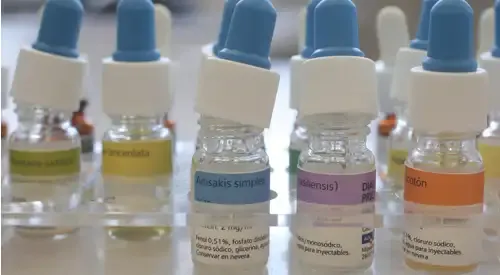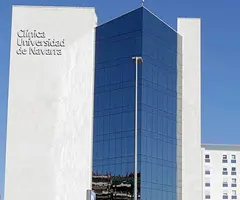Food Allergy
"When a patient is sensitized to multiple foods, we help him/her to configure a balanced diet that ensures the nutritional needs and avoids the foods indicated by the allergology specialist".
DR. MARÍA JOSÉ GOIKOETXEA
SPECIALIST. ALLERGY AND IMMUNOLOGY DEPARTMENT

What is food allergy?
A food allergy is an allergic reaction in which our body perceives a substance - usually a protein, which we call an allergen - as harmful, but which is not. This contact activates an exaggerated immune response that manifests itself in various organs of the body.
Milk, eggs and fish are the most frequent causes of allergy in children under 5 years old
From that age, vegetable foods, such as legumes, fruits, nuts or vegetables, which have allergenic proteins common with pollens, a frequent cause of allergy from the age of 15, are more frequent.
Depending on the severity of the patient's reactions and the type of allergen to which he or she is sensitized, the food restriction will be more or less extensive.
In the Department of Allergology of the Clinic we have wide experience in the treatment of induction of oral tolerance and each patient is assessed individually. During the whole process it is supervised by our team of allergists and nurses specialized in the control of this treatment.

What are the common symptoms of food allergy?
Dependerá de la edad y del alimento implicado
Most food-allergic patients remain asymptomatic by avoiding eating the food, but some have symptoms with very small amounts of the food (traces), which may be found in unsuspected ways as contaminants. These detector patients are especially at risk.
The first symptom is usually an intense itching in the mouth and/or palate when the food is ingested. Other times it is manifested by a rash on the skin: hives with intense itching (urticaria).
It can cause digestive symptoms: vomiting or diarrhea. Or respiratory: sneezing, stuffy nose or difficulty breathing.
Many times, especially in children, a food allergy produces only asthma.
In more severe cases, ingestion of the food may trigger anaphylactic shock. In anaphylaxis, within minutes, intense itching of the scalp, palms and soles, with generalized reddening of the skin, difficulty in breathing, hypotension and loss of consciousness.
Anaphylaxis is a vital medical emergency. This reaction does not depend on the amount of food ingested, but on the sensitivity of the patient. Therefore, it is vital in these patients not to come into contact with even insignificant amounts of food. The foods that most frequently produce this anaphylactic reaction are peanuts and shellfish.
Most common symptoms of food allergy:
- Itching of the mouth and palate
- Hives and rashes on the skin
- Vomiting and/or diarrhea
- Respiratory distress
Do you have any of these symptoms?
You may have a food allergy
¿Cuáles son las causas de la alergia alimentaria?
Any food can cause an allergic reaction:
- In children under 5, milk, eggs and fish are the most common causes.
- From the age of 5, vegetable foods such as legumes, fruits, nuts or vegetables are more common
- From the age of 15, pollens are the most common cause of allergy
The most common allergens are:
- Severe allergens: peanuts
- Strong allergens: cereals with gluten (oats, wheat, barley, rye), seafood, eggs, fish, soya, milk proteins, nuts (almonds, hazelnuts, pistachios, walnuts, pine nuts etc.)
- Mild allergens: celery, stone fruits (apricots, cherries, peaches and plums)
An increasing problem is that of people who are sensitized to multiple plant food groups. In these cases, the question is which foods can be eaten safely and which cannot. A wide restriction can raise doubts about the nutritional value of the diet and its possible vitamin deficiencies. In addition, sometimes it is difficult to know which food involved causes the reaction.
Is it the same intolerance as food allergy?
The term "food intolerance" is not synonymous with food allergy. Intolerances (the most frequent is to lactose) are caused by enzymatic deficiencies.
The symptoms are usually very nonspecific, with alterations of the intestinal rhythm, flatulence, bad digestions, diffuse abdominal pain, etc.
Studies are usually carried out to diagnose an intolerance in a specific way (lactose intolerance test).
However, tests to measure food intolerance in general, which have become widespread in recent years, do not have scientific support and have not demonstrated clinical utility. In cases of non-specific digestive symptoms, it is advisable to rule out food allergy.
How is food allergy diagnosed?

The diagnosis is made by means of a very simple skin test: drops containing a known amount of the allergen to which we may be sensitive are applied to the skin of the arm. The basis of this technique is to reproduce in the skin the reaction that we present in other parts of the body.
In addition, it is possible to perform blood tests, so that in a more precise way we can quantify and demonstrate the presence of specific antibodies against that allergen.
In the case of foods, sometimes it is necessary to make a provocation test, which consists of observing under medical control the reaction that takes place after the ingestion of the food.
In addition to the usual skin tests, we can measure IgE by microarrays, which gives us valuable information about the allergens that the patient recognizes.
How is food allergy treated?
We have great experience in desensitizing to different foods such as eggs, milk and now also fish
Treatment of food allergy
The first and most effective measure is to avoid contact with the allergen.
Secondly, there are medications that are very effective in treating symptoms, such as antihistamines -now also available in eye drops and nose drops-, topical corticosteroids -inhaled by mouth or nose that unlike corticosteroids taken by mouth are barely reabsorbed by the body and therefore lack systemic effects-, among other drugs.
The Clinica Universidad de Navarra is the first health center in Navarra to offer a treatment to eliminate allergic reactions to milk and eggs. The desensitization treatment allows patients to consume these foods without allergic reactions in two months (milk) and between three and four months (egg).
How is food desensitization performed?
The desensitization treatment consists of initially administering very low doses and gradually increasing the dose, progressively and very slowly, until a complete ration of fish is tolerated.
This treatment requires that at all times, health personnel closely control this process to avoid significant allergic reactions.
This is complemented with education to the patient and his family to teach them to avoid contact with this food and learn to act against serious allergic reactions.
What clinical trials do we have on alergias alimentarias?
Where do we perform food allergy treatment?
IN NAVARRE AND MADRID
Department of Allergology
of the Clínica Universidad de Navarra
The Department of Allergy and Immunology of the Clinic is part of the Global Allergy and Asthma European Network, composed of the 25 best departments of Allergy in Europe, chosen for their scientific excellence, multidisciplinary work, teaching and international activities.
We have the most advanced diagnostic techniques, we are at the forefront of research and we collaborate with the best experts. We have more than 50 years of experience in the field.
What diseases do we treat?

Why at the Clinica?
- More than 50 years of experience.
- Pioneers in the technique of molecular diagnosis by microarray.
- Nursing specialized in allergic diseases and their care.








